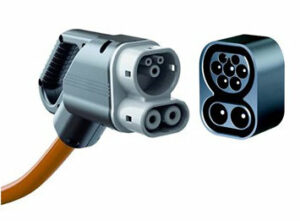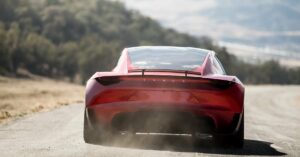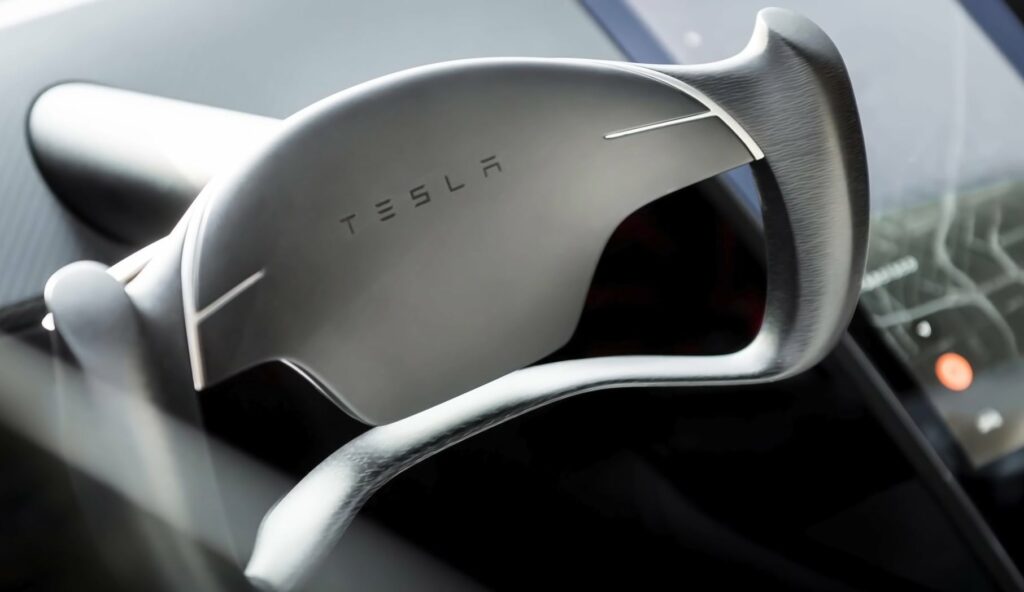Tesla Roadster
A trailblazer in electric supercars is the Tesla Roadster.
Introduction
Produced by Tesla, Inc., the Tesla Roadster is an all-electric supercar. It was the first production car to utilize lithium-ion battery technology, making it a high-performance and greener option for sports cars with gas engines. Only 2,500 Roadsters were produced between 2008 and 2012, during which time it was in production.

Features and Design Tesla Roadster
Four people can sit in the two-door convertible known as the Roadster. It has a streamlined, aerodynamic body form that is designed to lower drag and increase effectiveness. The car has individual electric motors at each wheel and all-wheel drive. As a result, the wheels receive the most power transfer and can be controlled precisely. Regenerative braking is another feature of the Roadster that features the vehicle’s range by recapturing energy lost during braking and sending it back to the battery.
The interior of the Roadster was also designed with the newest technology in mind. The dashboard’s touchscreen display is internet-connected, enabling real-time information on the condition and performance of the vehicle. The car also has a satellite navigation system and an integrated GPS system.

Performance Tesla Roadster
Where the Roadster really excels is in its electric drivetrain. One of the fastest cars in the world, it can go from 0 to 60 mph in under 2.1 seconds. The Roadster’s top speed exceeds 450 km/h, making it faster than the majority of gas-powered supercars. The car’s range of 410 km on a single charge is more than sufficient for the majority of lengthy journeys. Additionally, the Roadster’s outstanding 1 200 Nm of torque enables quick acceleration and an exhilarating driving experience.

Accessibility and cost of Tesla Roadster
With only 2,500 units produced, the Tesla Roadster was produced from 2008 to 2012. The car’s initial suggested retail price was somewhere around $109,000. The Roadster has grown in popularity and vehicle as a result of its low production volume and high demand.

The Tesla Roadster’s benefits include:
Extremely quick acceleration: The Roadster is one of the fastest production cars in the world, making 60 mph in under 2.1 seconds.
Long driving range: The Roadster offers one of the longest electric driving ranges of any production automobile, with a range of 410 km on a single charge.
Low environmental impact: Compared to gasoline-powered cars, electric cars, like the Tesla Roadster, have a significantly smaller environmental impact.
Con drawbacks of the Tesla Roadster include:
High cost: With a starting price of about $200,000, the Roadster is a highly pricey vehicle.
A minimal amount of Roadsters will be produced by Tesla, making them hard to find and possibly subject to long waitlists.
Despite the Roadster’s long range, charging infrastructure is still necessary, and it takes longer than with gasoline-powered cars.
Storage: The Roadster’s limited storage space makes it less suitable for prolonged journeys or families.
Conclusion
In the market for electric vehicles, the Tesla Roadster blazed away. It demonstrated the promise of electric power in powerful cars and established a new benchmark for electric vehicles. It is a valuable and collectible vehicle for both car aficionados and proponents of electric vehicles due to its cutting-edge technology and strong performance specifications. The Roadster is evidence that electric cars can be strong, effective, and gorgeous.
| Performance | |
| Acceleration 0 – 100 km/h | 2.1 sec |
| Top Speed | 410 km/h |
| Electric Range | 970 km |
| Total Power | 1000 kW (1360 PS) |
| Total Torque | 1200 Nm |
| Drive | AWD |
| Battery and Charging | |
| Battery Capacity | 200.0 kWh |
| Battery Useable | 200.0 kWh |
| Europe | |
| Charge Port | Type 2 |
| Charge Power | 22 kW AC |
| Charge Time (0->970 km) | 10h45m |
| Charge Speed | 91 km/h |
| Fastcharge Port | CCS |
| Fastcharge Power (max) | 250 kW DC |
| Fastcharge Time (97->776 km) | 44 min |
| Fastcharge Speed | 920 km/h |
| Energy Consumption | |
| EVDB Real Range | |
| Range | 970 km |
| Vehicle Consumption | 206 Wh/km |
| CO2 Emissions | 0 g/km |
| Vehicle Fuel Equivalent | 2.3 l/100km |
|
Rated = official figures as published by manufacturer. Rated consumption and fuel equivalency figures include charging losses.
|
|
|
Vehicle = calculated battery energy consumption used by the vehicle for propulsion and on-board systems.
|
|
| Real Energy Consumption Estimation between 142 – 288 Wh/km | |
| City – Cold Weather * | 206 Wh/km |
| Highway – Cold Weather * | 288 Wh/km |
| Combined – Cold Weather * | 242 Wh/km |
| City – Mild Weather * | 142 Wh/km |
| Highway – Mild Weather * | 227 Wh/km |
| Combined – Mild Weather * | 183 Wh/km |
| Energy use for each trip will vary considerably depending on the driver and the conditions. Therefore, we have provided a range of estimates which can be useful in developing an understanding of the potential benefits of this technology. | |
| Dimensions and Weight | |
| Length | 4200 mm |
| Width | 2000 mm |
| Width with mirrors | No Data |
| Height * | 1200 mm |
| Wheelbase | 2800 mm |
| Weight Unladen (EU) | 2000 kg |
| Gross Vehicle Weight (GVWR) | No Data |
| Max. Payload | No Data |
| Cargo Volume | No Data |
| Cargo Volume Max | No Data |
| Cargo Volume Frunk | No Data |
| Roof Load | No Data |
| Tow Hitch Possible | No Data |
| Towing Weight Unbraked | No Data |
| Towing Weight Braked | No Data |
| Vertical Load Max | No Data |
| Miscellaneous | |
| Seats | 4 people |
| Isofix | No Data |
| Turning Circle | No Data |
| Platform | No Data |
| Car Body | Cabriolet |
| Segment | H – Sports |
| Roof Rails | No Data |
| EV Dedicated Platform | No Data |
Home and Destination Charging (0 -> 100%)
A public charging station is required to use the highest possible charging rate. The EVSE/charging station’s charging capacity affects how long it takes to fully charge the battery. The table below shows all possible options for fully charging the Tesla Roadster.
In Europe, plugging an electric car into an outlet is often as easy as plugging it into a household outlet, but there are differences from country to country. The table below shows the different ways to charge the Tesla Roadster, but in some countries some chargers may not be available.
Type 2 ( IEC 62196)

| Charging Point | Max. Power | Power | Time | Rate |
| Wall Plug (2.3 kW) | 230V / 1x10A | 2.3 kW | 102h30m | 9 km/h |
| 1-phase 16A (3.7 kW) | 230V / 1x16A | 3.7 kW | 63h45m | 15 km/h |
| 1-phase 32A (7.4 kW) | 230V / 1x32A | 7.4 kW | 32 hours | 30 km/h |
| 3-phase 16A (11 kW) | 400V / 3x16A | 11 kW | 21h30m | 45 km/h |
| 3-phase 32A (22 kW) | 400V / 3x32A | 22 kW | 10h45m | 90 km/h |
Fast Charging (10 -> 80%)
If you want to enjoy driving an electric car, one of the most important features to consider is the number of miles per hour the car can travel while charged. This is called the “range” of the car. All electric cars have a certain range, even if they are 100% charged. This is because they do not have an internal combustion engine to lean on if you need to drive a long distance.
Max. Power: The maximum power provided by the charging point
Avg. Power: The average power provided by the charging point during a session of 10% to 80%.
Time: the time it takes to charge from 10% to 80%
Speed: the average charging rate during the session of 10% to 80%
Combined Charging System (CCS Combo 2)
| Charging Point | Max. Power | Avg. Power | Time | Rate |
| CCS (50 kW DC) | 50 kW | 50 kW | 177 min | 230 km/h |
| Supercharger v2 Shared (75 kW DC) | 75 kW | 75 kW | 118 min | 340 km/h |
| Supercharger v2 (150 kW DC) | 150 kW | 130 kW | 68 min | 590 km/h |
| CCS (175 kW DC) | 175 kW | 150 kW | 59 min | 690 km/h |
| Supercharger v3 (250 kW DC) | 250 kW | 200 kW | 44 min | 920 km/h |
| CCS (350 kW DC) | 250 kW | 200 kW | 44 min | 920 km/h |
| Brand | Tesla |
| Model | Roadster |
| Body Style | Cabriolet |
| Car Engine | electric |
| Motor power | 1000 |
| Maximum Torque, Nm | 1200 |
| Battery Energy, kWh | 200.0 |
| Power reserve (NEDC/EPA/WLTP), km | - / - / 970 |
| Level Charging (230/400/DC), hours | - / 10.45 / 0.44 |
| Electrical Acceleration, 0-100 km/h (0-62.1 mph) in sec | 2.1 |
| Top Speed, km/h | 410 |





















